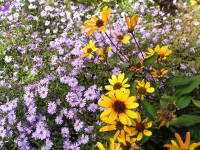Interest in native plants continues to grow, and at Pondside we offer many species, selections and cultivars from the rich North American flora.

Rudbeckia maxima, the Cabbage Leaf Coneflower, is a native of prairies and open meadows that adds a strong vertical accent to plantings.
There are so many reasons to incorporate native plants into our gardens. First, they’re naturally adapted to our climate. That means they can take our challenging winters, capricious springs and sweltering summers, and still perform beautifully with a minimum of coddling. And most of them are far less vulnerable to pests and diseases than are plants from other parts of the world, all of which translates into less work for the gardener.
There are many good cultivars of the native hollies, like this Ilex verticillata ‘Red Sprite’, that will fit into any home planting and be attractive to birds, and decorative too.
Bringing greater biodiversity to our plantings is another major reason to include natives in your plans. Countless species of birds, insects, even soil bacteria, depend on these plants for completion of their life cycle. Even a modest planting of natives can support an amazing variety of creatures, and helps maintain scattered islands of diversity in the face of increasing development, suburbanization and conformity in our landscape.

The Bowman’s Root, Gillenia trifoliata, is seldom grown but adds wonderful delicacy to shade plantings.
That they are beautiful is just as good a reason as any to plant American natives. Think of a Dogwood in full bloom, a meadow of Echinacea, Asters, Liatris and Switchgrass, a woodland pool overhung with Buttonbush and Witchhazel. Our part of the world is blessed with a richly diverse palette of indigenous plants, and we do well to take advantage of our good fortune.


